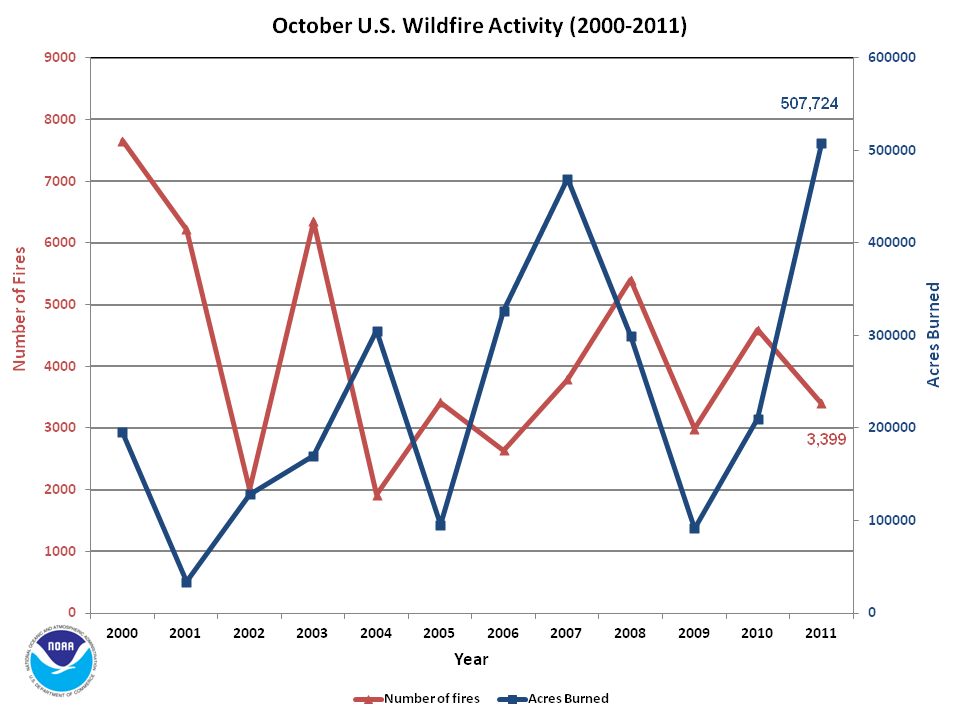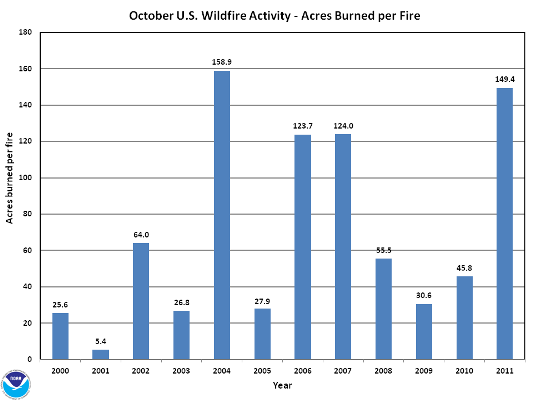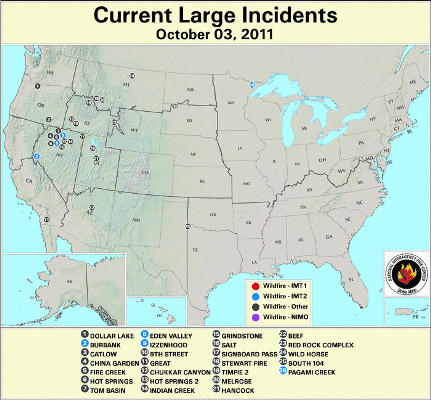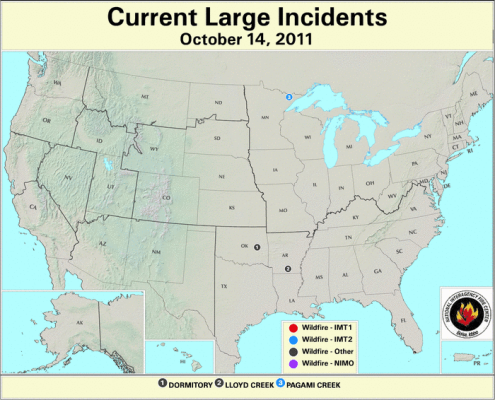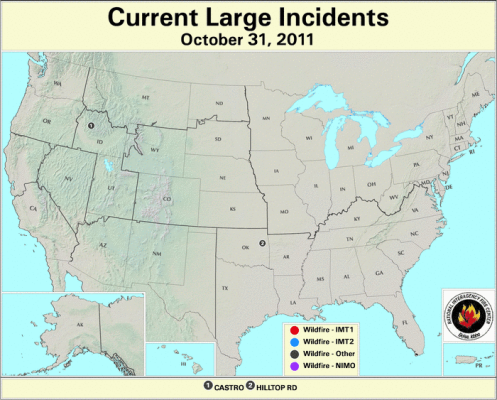Updated: 6 October 2011
Overview
During October 2011, approximately 507,724 acres (205,470 hectares) burned across the country, the most on record for the month. Most of the wildfire activity during the month occurred across the interior West, during the first two weeks of the month. The previous record for October acreage burned occured in 2007, when 469,496 acres (190,000 hectares) were burned. During the January-October period, 8.23 million acres (3.33 million hectares) burned across the U.S. — the 4th most in the 12-year period of record. The most acres burned during the January-October period occurred in 2006 when 9.40 million acres (3.80 million hectares) burned nationwide.
According to the National Interagency Fire Center (NIFC) :
For more wildfire statistics visit U.S. Wildfires.
Discussion
During October, wetter-than-normal conditions were present across the Northeast, and the interior western states. Drier-than-normal conditions dominated the month along the Mississippi Valley. The remainder of the country — the Southeast, Southern Plains, and Southwest — received near-normal precipitation amounts for the month. Two-thirds of the country had October temperatures which were near to above normal, while the Southeast was the only region of the country cooler than normal. See the U.S. Temperature and Precipitation discussion for more information. According to the U.S. Drought Monitor, the overall size of the drought footprint (D1-D4) expanded from 29.1 percent of the contiguous U.S. at the end of September to 32.6 percent of the contiguous U.S. at the end beginning of November. Meanwhile, the percent area of the contiguous U.S. experiencing Exceptional Drought (D4) shrank. Drought conditions remained generally unchanged across the Southeast, with the exception of a few locations that received isolated heavy rainfall during October. Beneficial precipitation across the Southern Plains improved drought conditions by one to two categories across northern Texas, eastern Oklahoma, and southeastern Kansas. Drought conditions also improved slightly across portions of southern Arizona. To the north, across the Central and Northern Plains, drought conditions worsened by one to two categories. Severe Drought (D2) conditions became more widespread during October across Iowa, Minnesota, and Illinois. A large area of the Northern Rockies was classified as being abnormally dry at the end of October.
Wildfire information and environmental conditions are provided by the National Interagency Fire Center (NIFC) and the U.S. Forest Service (USFS) Wildland Fire Assessment System (WFAS).
At the beginning of October, there were 26 large wildfires burning across the country. There were two large wildfires burning across the Pacific Northwest in interior Oregon (1) and Washington (1) where high fire danger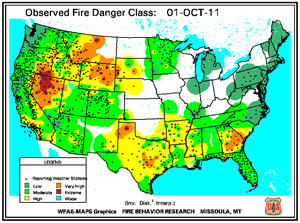 and extremely low 10-hour
and extremely low 10-hour fuel moistures were reported. Thirteen large wildfires were active across the Great Basin in Nevada (11) and Utah (2). Dry conditions dominated across the region during the end of September, increasing the fire danger
fuel moistures were reported. Thirteen large wildfires were active across the Great Basin in Nevada (11) and Utah (2). Dry conditions dominated across the region during the end of September, increasing the fire danger and Keetch-Byram Drought Index (KBDI),
and Keetch-Byram Drought Index (KBDI), drying fuels of all sizes (10-hour
drying fuels of all sizes (10-hour , 100-hour
, 100-hour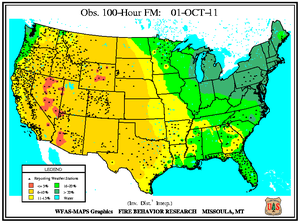 , and 100-hour
, and 100-hour fuel moistures). Seven large wildfires were burning across Idaho (3), Montana (3), and Wyoming (1), where high fire danger
fuel moistures). Seven large wildfires were burning across Idaho (3), Montana (3), and Wyoming (1), where high fire danger and low 10-hour
and low 10-hour and 100-hour
and 100-hour fuel moistures were reported. Two large fires burned in Southern California (1) and Arizona (1). Across the region, extremely low 10-hour
fuel moistures were reported. Two large fires burned in Southern California (1) and Arizona (1). Across the region, extremely low 10-hour fuel moistures were reported. One large wildfire was active in northern Texas, where on-going drought has caused fuels of all sizes to remain dry (10-hour
fuel moistures were reported. One large wildfire was active in northern Texas, where on-going drought has caused fuels of all sizes to remain dry (10-hour , 100-hour
, 100-hour , and 1,000-hour
, and 1,000-hour fuel moistures) and led to high KBDI
fuel moistures) and led to high KBDI values across the state. The Pagami Creek Fire in northern Minnesota continued to burn where low 10-hour
values across the state. The Pagami Creek Fire in northern Minnesota continued to burn where low 10-hour fuel moistures were reported.
fuel moistures were reported.
At mid-October, the large wildfire activity across the country subsided significantly, and only three large wildfires were active. Two large wildfires were burning across Oklahoma (1) and Arkansas (1). On-going drought across the region led to high fire danger . Reported 10-hour
. Reported 10-hour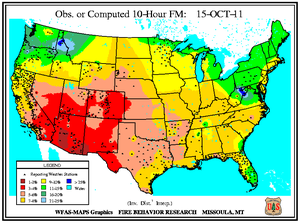 fuel moistures were also moderately low, with extremely high KBDI
fuel moistures were also moderately low, with extremely high KBDI values. The Pagami Creek Fire in northern Minnesota continued to burn during mid-October. Cooler temperatures helped to increased fuel moistures and lower fire danger
values. The Pagami Creek Fire in northern Minnesota continued to burn during mid-October. Cooler temperatures helped to increased fuel moistures and lower fire danger and KBDI
and KBDI values across the region, which aided fire fighters to fully contain the fire.
values across the region, which aided fire fighters to fully contain the fire.
By October 31st, only two large wildfires were burning across the country. One large fire was active in eastern Oklahoma, where ongoing drought has continued to create ideal wildfire conditions. The prolonged dry conditions caused high KBDI values across the region, while dry conditions on the shorter term dried out small fuels and lowered 10-hour
values across the region, while dry conditions on the shorter term dried out small fuels and lowered 10-hour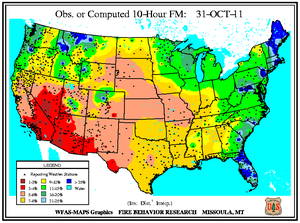 fuel moistures. The other large fire was burning in central Idaho. Relatively wet conditions the second half of the month caused low fire danger
fuel moistures. The other large fire was burning in central Idaho. Relatively wet conditions the second half of the month caused low fire danger across the region, but dry conditions over the longer term caused moderately low 100-hour
across the region, but dry conditions over the longer term caused moderately low 100-hour and 1,000-hour
and 1,000-hour fuel moistures.
fuel moistures.
 NOAA's National Centers for Environmental Information
NOAA's National Centers for Environmental Information
